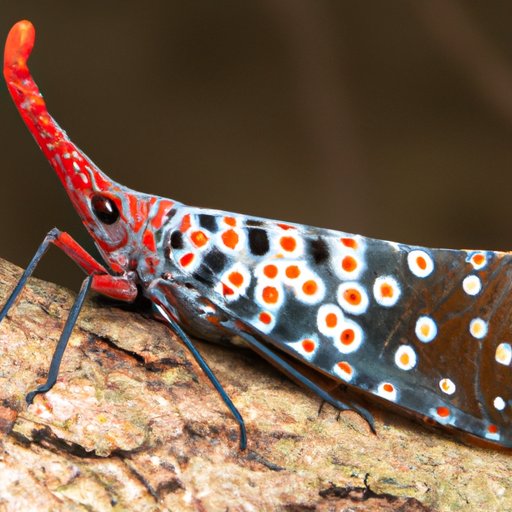
Introduction
Spotted lanternflies are an invasive insect species that pose a significant threat to agriculture. They were first discovered in the United States in 2014 and have since spread throughout many states, including Pennsylvania, New Jersey, and Maryland. These pests are known for their ability to cause damage to crops such as grapes, hops, fruit trees, and hardwood trees. They feed on sap, causing wilting, stunted growth, and in some cases, death. In this article, we will explore tips and strategies for getting rid of spotted lanternfly to help protect our agriculture industry.
Using Sticky Bands to Trap Spotted Lanternfly
One effective way to trap spotted lanternflies is by using sticky bands. These bands are made of a sticky, adhesive material that can be wrapped around tree trunks, branches, and other surfaces. When the spotted lanternflies come into contact with the sticky bands, they get stuck and are unable to move. This ultimately leads to their demise.
Applying sticky bands is relatively simple. First, you need to determine where to place them. Sticky bands should be applied to tree trunks about 4-5 feet from the ground. It’s important to wrap the sticky band tightly around the trunk while making sure that there are no gaps. This ensures that the spotted lanternflies will not be able to bypass the trap. Checking the traps every few days and replacing them as necessary is also essential.
The best surfaces to apply sticky bands are trees that are known to be hosts for spotted lanternflies. Some of the known hosts include the tree of heaven, grapevine, fruit trees, and hardwood trees. Using sticky bands on these trees will help prevent the spread of spotted lanternflies.
Eliminating Spotted Lanternfly Egg Masses
Spotted lanternflies lay their eggs in the fall, and these eggs overwinter, hatch in the spring, and emerge as nymphs. Eliminating egg masses is an important strategy for controlling spotted lanternfly populations.
Spotted lanternfly egg masses are usually found on trees, rocks, outdoor furniture, and other hard surfaces. They are characterized by their gray, putty-like appearance with a rough texture and can hold between 30 to 50 eggs each.
To get rid of spotted lanternfly egg masses, you should scrape them off the surface using a plastic card or putty knife. The egg masses should be collected and disposed of in a container filled with rubbing alcohol, hand sanitizer, or soapy water. This prevents them from hatching and infecting crops and trees in the spring.
Chemical Treatments to Control Spotted Lanternfly
Chemical treatments are another strategy for controlling spotted lanternflies. There are several chemical options available, including insecticides, which are applied directly to the tree trunks or foliage. These chemicals can kill spotted lanternflies and disrupt their growth and development.
However, there are pros and cons to using chemical treatments. The main advantage is that they are effective in controlling spotted lanternflies. On the other hand, there are serious safety concerns related to the use of chemicals. Pesticides can harm other insects and pollinators, and they can also harm humans and other animals if not used correctly.
If you decide to use chemical treatments, it’s important to read the label carefully and follow the instructions. Wear protective clothing and equipment, and avoid applying the insecticide when it’s windy or during hot temperatures.
Encouraging Natural Predators of Spotted Lanternfly
Encouraging natural predators is another strategy for controlling spotted lanternflies. Certain predatory insects, such as the praying mantis, spiders, and birds, can feed on spotted lanternflies and help keep their populations under control.
One way to attract natural predators is by planting native trees, shrubs, and flowers in your yard. These plants provide a habitat for predatory insects and encourage biodiversity. Creating habitats for natural predators also helps reduce the need for chemical treatments, which is better for the environment and other animals.
It’s essential to balance predator populations, however. Too many predatory insects can harm other insects and disrupt the ecosystem. You should monitor the populations of natural predators and adjust your efforts accordingly.
Pruning Heavily-Affected Sections of Trees
Pruning is a useful strategy for preventing the spread of spotted lanternfly. Cutting off the heavily-affected sections of trees, such as the branches with spotted lanternfly egg masses or nymphs, can prevent the insect from spreading to other parts of the tree or nearby trees.
It’s important to prune at the right times of the year, which are usually in the fall or winter when the insect is less active. Pruning during the fall and winter also reduces the likelihood of the insect laying eggs on the cut surfaces.
When pruning, it’s essential to wear protective clothing and equipment, such as gloves and eye protection. You should also disinfect your pruning tools before and after use to prevent the spread of the insect.
Preventing a Spotted Lanternfly Infestation
Preventing an infestation is the best way to control spotted lanternfly populations. It’s crucial to monitor outdoor equipment, such as grills, lawn furniture, and vehicles, for the presence of spotted lanternflies. You should inspect any item that has been outside and remove any eggs and nymphs that you find.
Avoiding potential sources of spotted lanternfly is also key. You should avoid transporting firewood, stone, and other hard outdoor items that could harbor the insect. It’s also best to avoid buying plants online or from out-of-state nurseries, as they may be infected with spotted lanternflies.
Conclusion
Spotted lanternflies are a significant threat to agriculture, but there are strategies that we can use to control their populations. These include using sticky bands, eliminating egg masses, using chemical treatments, encouraging natural predators, pruning heavily-affected sections of trees, and preventing an infestation.
We encourage everyone to take action against the spread of spotted lanternfly. By working together, we can protect our crops, our trees, and our environment from these invasive pests.




